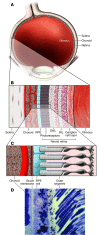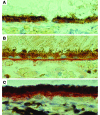Therapeutic targets in age-related macular disease
- PMID: 20811159
- PMCID: PMC2929720
- DOI: 10.1172/JCI42437
Therapeutic targets in age-related macular disease
Abstract
Age-related macular disease (AMD) accounts for more than 50% of blind registration in Western society. Patients with AMD are classified as having early disease, in which visual function is well preserved, or late disease, in which central vision is lost. Until recently, there was no therapy available by which the course of the disorder could be modified. Now, the most common form of late-stage AMD - choroidal neovascularization - responds to treatment with anti-VEGF therapies; although visual loss is modified in a portion of these cases, no therapeutic approach exists that alters the evolution from early to late disease. However, as discussed in this Review, research over the last few years has demonstrated several features of AMD that are likely to be amenable to treatment. Potential targets for treatment are described, and possible therapeutic approaches are discussed.
Figures





References
-
- Evans J. Studies on Medical and Population Subjects No 57. HMSO; 1995. Causes of blindness and partial sight in England and Wales 1990–1991.
-
- Ophthalmology. 1992;99(6):933–943. - PubMed
-
- Mitchell P, Smith W, Attebo K, Wang JJ. Prevalence of age-related maculopathy in Australia. The Blue Mountains Eye Study. Ophthalmology. 1995;102(10):1450–1460. - PubMed
-
- Vingerling JR, et al. The prevalence of age-related maculopathy in the Rotterdam Study. Ophthalmology. 1995;102(2):205–210. - PubMed
-
- Hutchinson J, Tay W. Symmetrical central choriodol-retinal disease occurring in senile persons. . R Lond Ophthalmic Rep. 1874;8:231–244.
Publication types
MeSH terms
Substances
LinkOut - more resources
Full Text Sources
Other Literature Sources
Medical

